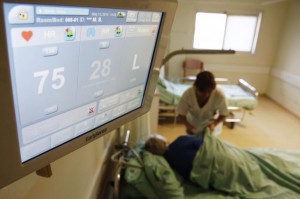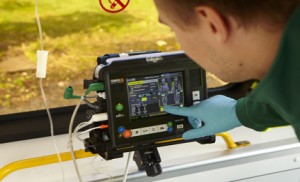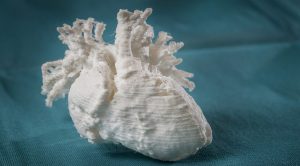
How Technology Disruption Is Changing The Future Of Healthcare
Technological disruption is transforming every aspect of the future of healthcare: from how patients are diagnosed to how they’re treated. Cutting-edge technologies like Artificial Intelligence, Internet of Things or 3D printing are no longer a sci-fi fantasy. They will enter the healthcare market sooner than we think.
In 2016, the global digital health market was valued at US$ 179.6 billion. By 2025, it’s predicted to shoot up to US$ 536.6 billion. The rapid growth in the next decade will bring a change that can save many lives. But with new developments in the future of healthcare also come new challenges and researchers will need to address them soon.
Future of Healthcare: Better diagnosis with AI
 Artificial Intelligence (AI) can solve the problem of misdiagnosis as well as making hospital workflows more efficient. For example, researchers recently rolled out an AI program that reliably interprets mammograms. It can diagnose a patient 30 times faster than a human doctor, with 99% accuracy. For comparison, currently half of the mammograms yield false results. AI can boost accuracy from 50 to near 100 per cent and do it faster than a human.
Artificial Intelligence (AI) can solve the problem of misdiagnosis as well as making hospital workflows more efficient. For example, researchers recently rolled out an AI program that reliably interprets mammograms. It can diagnose a patient 30 times faster than a human doctor, with 99% accuracy. For comparison, currently half of the mammograms yield false results. AI can boost accuracy from 50 to near 100 per cent and do it faster than a human.
Apart from that, AI can assist doctors in accessing medical knowledge. An algorithm can memorize the entire existing medical knowledge and provide physicians with information relevant to their case by matching the database to a patient’s health records.
Employing AI in medicine will not only speed up processes but also cut costs and take a load off understaffed medical facilities.
Real-time alerts thanks to IoT
 Internet of Things (IoT) has been in our homes, pockets, and cars for a while now. But with more advanced medical technologies, we are now being introduced to a new concept – Internet of Medical Things.
Internet of Things (IoT) has been in our homes, pockets, and cars for a while now. But with more advanced medical technologies, we are now being introduced to a new concept – Internet of Medical Things.
What exactly is the Internet of Medical Things used for? It can be helpful for automatic or semi-automatic drug administration, especially for elderly patients. Portable diagnostic devices can also help track vitals and heart performance. Teamed up with powerful AI, IoT devices can additionally analyze the tests and send reports to the doctor’s office. In emergency situations, devices like high-tech pacemakers will even send alerts to the hospital and get help on the way for a better future of healthcare.
Future of healthcare, emergency care goes digital
 Not only phones are getting smaller, so are medical devices. More portable imagining machines will give emergency physicians better information at the site and en route to the hospital. Point of care ultrasound machines can identify injuries, such as bleeding in the abdomen, gallstones, kidney obstructions, or acute heart failure.
Not only phones are getting smaller, so are medical devices. More portable imagining machines will give emergency physicians better information at the site and en route to the hospital. Point of care ultrasound machines can identify injuries, such as bleeding in the abdomen, gallstones, kidney obstructions, or acute heart failure.
For the future of healthcare, new opportunities for telemedicine will also make it easier to consult specialists around the world. We’re about to see more and more ED treatment rooms equipped with cameras and high-speed internet. This is especially important for rural facilities that don’t have access to a specialist doctor.
Augmented Reality surgeries
 Augmented Reality can be used for a lot more than making games like PokemonGo. AR can provide real-time patient information to surgeons during both simple and complex procedures.
Augmented Reality can be used for a lot more than making games like PokemonGo. AR can provide real-time patient information to surgeons during both simple and complex procedures.
Surgeons will be able to enter a patient’s MRI data and CT scans into an AR headset and overlay specific patient anatomy on top of their body before actually going into surgery. For the first time in history, it will be possible to accurately visualize bones, muscles, and internal organs without even having to cut open a body.
What about safety?
 All these new technologies for the future of healthcare promise better workflows, improved efficiency, and more saved lives in the long run. But before we get there, there are some serious challenges for high-tech healthcare.
All these new technologies for the future of healthcare promise better workflows, improved efficiency, and more saved lives in the long run. But before we get there, there are some serious challenges for high-tech healthcare.
The biggest obstacle is cybersecurity. This is especially important in the case of medical IoT devices. Connected devices have a bad reputation for security and for good reasons. Manufacturers are often using outdated operating systems and skip security testing, putting users at risk of cyberattacks.
In a shocking 2018 experiment, a pair of security researchers remotely disabled an implantable insulin pump and took total control of a pacemaker system. In another experiment, a simulated human iStan was tortured and killed with his connected pacemaker. These simulations show that security vulnerabilities in medical devices could be lethal to patients.
IoT devices used exclusively at home can be encrypted with a VPN installed directly on the Wi-Fi router. VPN, or Virtual Private Network, encrypts the Internet traffic and prevents third parties from accessing the data stream to and from a device. Unfortunately, this strategy doesn’t work for on-the-go devices like pacemakers. Once a user is outside their secure network, they are prone to hacking again.
The future of healthcare
By some estimates, life expectancy will be 4.4 years higher for both women and men around the globe by 2040. High-tech healthcare will no doubt play an important role in achieving that number.
But there is a serious threat looming over the benefits of tech in medicine. One can easily imagine a future where medical devices are used by cybercriminals to blackmail or torture patients. Users shouldn’t need technologic expertise to secure their devices with homemade techniques. The safety measures need to be an integral part of the product development from day one to ensure the safety of all of the patients.


